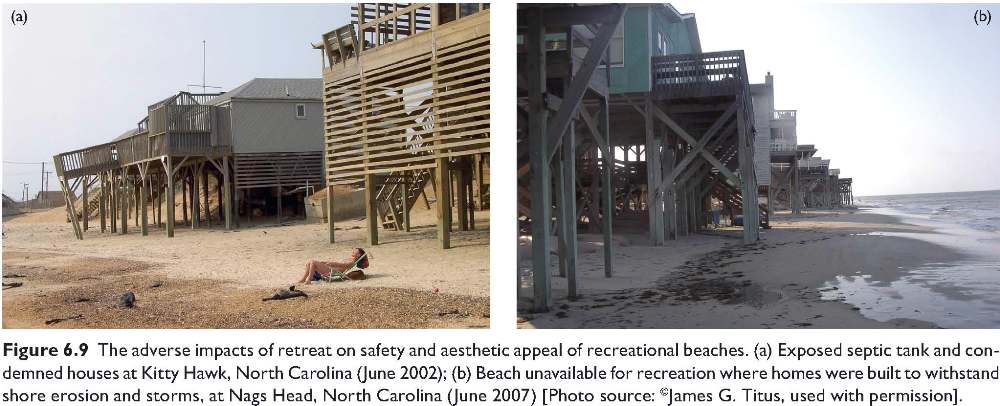- Shoreline Armoring
- Elevate Land
- Hybrid Shore Protection
- Retreat
- Consequences of Protection
- Sustainability
- Planning Maps
Shore Protection and Retreat: Societal Consequences
Related Links
U.S. Global Change Research Program
Other EPA-sponsored Climate Change Science Program Synthesis and Assessment Reports
From
Shore Protection and Retreat by James G. Titus and Michael Craghan (2009), which was chapter 6 of the Bush Administration's
published sea level rise assessment, entitled Coastal Sensitivity to Sea Level Rise
Outline of the Chapter
- 6.1 Techniques for Shore Protection and Retreat
- 6.1.1 Shore Protection
- 6.1.2 Retreat
- 6.1.3 Combinations of Shore Protection and Retreat
- 6.2: What factors influence the decision whether to protect or retreat?
- 6.3: What are the environmental consequences of retreat and shore protection?
- 6.4: What are the societal consequences of retreat and shore protection?
- 6.5: How sustainable are retreat and shore protection?
6.4 What are the societal consequences of shore protection and retreat as sea level rises?
6.4.1 Short-Term Consequences
Shore protection generally is designed to enable existing land uses to continue. By insulating a community from erosion, storms, and other hazards, the social consequences of sea-level rise can be minimal, at least for the short term. In the Netherlands, shore protection helped to foster a sense of community as residents battled a common enemy (Disco, 2006). In other cases, the interests of some shorefront property owners may diverge from the interests of other residents (NRC, 2007). For example, many property owners in parts of Long Beach Island, New Jersey strongly supported beach nourishmentóbut some shorefront owners in areas with wide beaches and dunes have been reluctant to provide the state with the necessary easements (NJDEP, 2006; see Section A1.C.2 in Appendix 1).
Allowing shores to retreat can be disruptive. If coastal erosion is gradual, one often sees a type of coastal blight in what would otherwise be a desirable community, with exposed septic tanks and abandoned homes standing on the beach, and piles of rocks or geotextile sand bags in front of homes that remain occupied (Figures 6.8b and 6.9). If homes are destroyed during a storm, communities can be severely disrupted by the sudden absence of neighbors who previously contributed to the local economy and sense of community (IPCC, 1990; Perrin et al., 2008; Birsch and Wachter, 2006). People forced to relocate after disasters are often at increased risk to both health problems (Yzermans et al., 2005) and depression (Najarian et al., 2001).

6.4.2 Long-Term Consequences
The long-term consequences of a retreat can be similar to the short-term consequences. In some areas, however, the consequences may become more severe over time. For example, a key roadway originally set far back from the shore may become threatened and have to be relocated. In the case of barrier islands, the long-term implications of retreat depend greatly on whether new land is created on the bay side to offset oceanfront erosion (see Section 12.2.1). If so, communities can be sustained as lost oceanfront homes are rebuilt on the bay side; if not, the entire community could be eventually lost.
The long-term consequences of shore protection could be very different from the short-term consequences. As discussed below, shore protection costs could escalate. The history of shore protection in the United States suggests that some communities would respond to the increased costs by tolerating a lower level of shore protection, which could lead eventually to dike failures (Seed et al., 2005; Collins, 2006) and resulting unplanned retreat. In other cases, communities would not voluntarily accept a lower level of protection, but the reliance on state or federal funding could lead to a lower level while awaiting funds (a common situation for communities awaiting beach nourishment). For communities that are able to keep up with the escalated costs, tax burdens would increase, possibly leading to divisive debates over a reconsideration of the shore protection strategy.
- For previous reports focused on the implications of rising sea level, go to More Sea Level Rise Reports.

 6.3: What are the environmental consequences of retreat and shore protection?
6.3: What are the environmental consequences of retreat and shore protection?